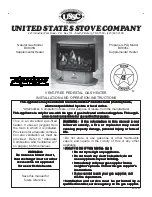
Innovation Water Heaters
– Edge [i] Controller
Venting and Combustion Air Design Guide
TAG-0090_A
•
GF-5056
•
2/20/2020
Technical Support
•
(800) 526-0288
•
Mon-Fri, 8 am - 5 pm EST Page 8 of 39
2.
COMBUSTION AIR SYSTEM
WARNING
AIR OPENINGS TO COMBUSTION AREA MUST NOT BE OBSTRUCTED. USE THE
INFORMATION BELOW TO ENSURE THAT ADEQUATE COMBUSTION AIR IS
MAINTAINED.
2.1.
Combustion Air Requirements
Innovation water heaters require the following combustion air volumes when operated at full
capacity:
INNOVATION-EDGE
INN 600N
– 130 SCFM (2.8 m
3
/min)
INN 800N
– 170 SCFM (4.8 m
3
/min)
INN 1060N
– 225 SCFM (6.4 m
3
/min)
INN 1350N
– 285 SCFM (8.1 m
3
/min)
These flows MUST be accommodated. Air supply is a direct requirement of NFPA 54, CSA
B149.1-10 (Canada) and local codes that should be consulted for correct design implementation.
NOTES:
1. Intakes must be located to prevent infiltration of chlorine, chlorides, halogens or any other
chemicals that are detrimental to the operation of combustion equipment. Common sources
of these chemicals are swimming pools, degreasing compounds, water softener salts,
plastic processing and refrigerants. This will ensure the longevity of the equipment and
maintain warranty validation.
WARNING:
If the equipment room is in the vicinity of any these types of chemicals, it must be supplied
with clean combustion air. The equipment room must also have a slightly positive room air
pressure, provided by a powered combustion air supply louver or duct, to prevent infiltration
of chemicals into the room.
2. When calculating free area using louvers and grilles, the required size of the openings for
combustion, ventilation, and dilution air shall be based on the total free area of each opening.
•
If the free area through a designed louver or grille is known, it shall be used in calculating
the size of opening required to provide the free area specified.
•
If the louver and grille design free areas are
not
known, the following will be assumed: For
wooden louvers a 25 percent free area; for metal louvers and grilles a 75 percent free area
opening.
3. When terminating the combustion air through the roof:
•
The combustion air inlet must be 3 ft. (0.9 m) below any vent outlet within 10 ft. (3 m) (see
Figure 10).
•
The combustion air inlet must also face away from the vent outlet (see Figure 10).
4. All inlet air ducts must be sealed air tight.









































